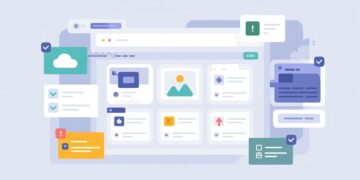Table of Contents
- Why Students Need Cybersecurity Skills Early On
- Fundamental Cyber Skills for Students
- Practical Cyber Habits to Teach at Home and School
- How Cyber Threats Specifically Target Young Users
- Best Resources for Cybersecurity Learning
- Encouraging Diversity and Inclusion in Cybersecurity
- Moving Toward Digital Confidence
Why Students Need Cybersecurity Skills Early On
The digital world is woven into nearly every aspect of students’ lives, from homework assignments and research projects to social interactions and gaming. As early as elementary school, kids are creating digital identities that can affect both their present and future. Without proactive guidance, students can inadvertently expose themselves to risks that threaten personal safety, academic integrity, and emotional well-being.
The need for comprehensive student cybersecurity education is greater than ever, especially since school networks and student accounts have become favored targets for cybercriminals. Parents and teachers who invest time in basic cyber lessons empower students to identify red flags online and act wisely in digital situations, thereby reducing vulnerability before problems arise.
Phishing scams that are cleverly disguised as school notices and the unfortunate rise in cyberbullying incidents are, sadly, becoming increasingly common in today’s digital landscape. One in-depth investigation conducted by NBC News has highlighted the alarming and growing volume of various cyber threats that are adversely impacting schools across the nation. The report specifically noted key contributing factors such as significant security lapses and a pervasive lack of awareness about these threats among educators and staff members. Building robust and sound cybersecurity habits isn’t only about effectively stopping hackers and other malicious actors—it’s also fundamentally about creating a much safer environment where students can thrive and flourish as responsible digital citizens in an interconnected world.
Fundamental Cyber Skills for Students
Foundational cyber skills begin with careful and effective communication as well as the development of smart and responsible habits. It is crucial that every student learns to identify and recognize suspicious emails, understand the significance of urgent or unusual requests for private information, and develop a healthy skepticism toward unsolicited links or attachments. It’s surprisingly easy for malicious attackers to mimic the emails of teachers or administrators with just minor variations in spelling or phrasing, which can easily trick unsuspecting students into clicking on something dangerous that could compromise their security and privacy.
A solid and comprehensive cybersecurity education also means equipping students with the essential tools and practices required to manage their digital identities responsibly and safely. They should be coached on the importance of creating unique and complex passwords for different online platforms, changing them regularly, and being cautious to avoid writing them down in places where others can easily see them. Utilizing password managers is a strategic practice that can further reduce the risks associated with password reuse, which remains a top vulnerability exploited in attacks targeting students and their credentials.
Furthermore, understanding platform privacy settings—found in various social applications and educational software—is another crucial lesson that students should learn. They should regularly review and adjust these settings to ensure that only trusted friends or necessary parties can see their posts, access their personal information, or message them directly. Emphasizing the importance of two-factor authentication adds another valuable layer of security that helps protect their accounts, as this method requires users to provide a code or confirmation that strengthens their logins against potential intrusions and unauthorized access.
Key Takeaways
- Basic cybersecurity skills arm students to handle online threats and digital challenges in everyday life.
- Establishing strong cyber habits early shields students’ data, reputations, and mental health.
- Practical and critical thinking skills are equally vital for robust digital safety.
- Engaged educators and families can create environments that nurture cyber awareness and responsibility.
- A wide array of learning resources and programs is available to help students grow as digital citizens.
Practical Cyber Habits to Teach at Home and School
Cybersecurity champions aren’t just the dedicated IT staff at schools or organizations; rather, parents, teachers, and even peers play a significantly major role in helping to keep daily habits sharp and secure. Maintaining and keeping a dialogue open—where students genuinely feel comfortable admitting mistakes or asking various questions—is absolutely critical to fostering a safer digital environment. Mistakes should be viewed as valuable learning opportunities, not as moments for feelings of embarrassment or harsh punishment.
Together, families and classrooms alike can collaboratively establish essential digital ground rules. These guidelines may include important practices, such as never sharing sensitive login credentials with classmates, and always asking for permission before downloading new applications. Revisiting and reinforcing these rules at set times (such as at the beginning of a new semester or whenever a new device comes home) helps to ensure that expectations remain fresh and relevant in light of evolving technological trends.
Real-world events and discussions can help make complex issues feel less abstract and more tangible. Engaging in conversations about current news reports that highlight student-targeted malware attacks or social engineering attempts effectively grounds the lessons in reality. As students begin to see familiar scenarios and threats reflected in the media, the persistent “it could never happen to me” mindset gradually fades away, paving the way for genuine caution and resilience in their digital lives.
How Cyber Threats Specifically Target Young Users
Young technology users, including students and young professionals, represent a particularly appealing target demographic for malicious attackers, partly due to their inherent openness, youthful curiosity, and a noticeable lack of hard-earned skepticism developed over time through experience. Phishing efforts may cleverly utilize recognizable school emblems or other official-looking graphics to mimic trusted administrators, making such deceptive techniques more convincing. Social engineering strategies manipulate students into providing sensitive, private information or clicking on potentially harmful, malicious content, sometimes even convincing them to inadvertently bypass well-intentioned school firewalls designed to protect their online activities.
Deceptive email hoaxes—such as those promising extra credit or urgent scholarships—are carefully crafted to elicit clicks quickly before the targets have a chance to develop any skepticism or second thoughts. Additionally, fraudulent contests that offer “free stuff,” along with fake internship offers, are often designed to extract personal data or account details from unsuspecting victims.
Moreover, malware infections often masquerade as legitimate educational tools or attractive add-ons for widely popular games, tricking users into downloading harmful software. The phenomenon of online impersonation is also alarming, where attackers or online bullies establish fake accounts with the intent to harass, intimidate, or embarrass their victims, causing significant emotional distress.
School districts have, unfortunately, experienced extensive disruptions when these malicious attacks escalate beyond affecting individual victims and expand into entire networks. A recent Education Week report highlights the significant impact of ransomware attacks on hundreds of schools, resulting in considerable loss of instructional time and the exposure of sensitive data belonging to students and their families. These alarming incidents underscore the critical importance of maintaining everyday vigilance and awareness in our increasingly digital world.
Best Resources for Cybersecurity Learning
The right approach to cybersecurity education strikes a balance between play and practicality. Today, students can practice real-world skills in safe, gamified environments—solving puzzles, waging “defense” against simulated attacks, and earning badges for smart choices. Materials are often broken down into short clips or interactive quizzes, making learning approachable for different age groups.
National events like CyberPatriot spice up digital safety lessons by fostering competition and teamwork, while local workshops inspire through hands-on explorations of digital forensics and ethical hacking. Importantly, materials from government agencies and reputable nonprofits walk families and teachers through everyday best practices, supplementing classroom lessons or home discussions.
With options for all learning styles—visual, kinesthetic, or written—students can learn to spot scams, create tough passwords, and guard their digital footprints. Even a single session or guided lesson has the potential to inspire lifelong vigilance.
Encouraging Diversity and Inclusion in Cybersecurity
The expansive and continuously evolving field of cybersecurity benefits enormously from a diverse range of perspectives and experiences, making it richer and substantially more effective. However, it is important to note that girls, students of color, and students hailing from rural areas continue to be significantly underrepresented in various cyber roles, which can limit the potential for innovation and progress. By introducing engaging digital safety workshops and dynamic coding clubs at an early education level, we can effectively break down the pervasive stereotype that cybersecurity is a field reserved only for a select few individuals with specialized backgrounds.
Currently, numerous nonprofits, supportive industry partners, and a wide array of school districts are taking proactive steps to host an increasing number of programs and mentorship initiatives specifically tailored to support these underrepresented groups. This crucial effort reinforces the empowering idea that everyone, regardless of their background, possesses unique skills and talents to contribute to the field of cybersecurity. Furthermore, providing students with exposure to real-life cyber role models, along with organizing inclusive competitions, can significantly help these young minds envision their own potential role in safeguarding tomorrow’s digital frontiers, thereby inspiring them to play a vital part in securing our interconnected world.
Moving Toward Digital Confidence
A culture of digital safety begins by laying a solid foundation grounded in education, which is then followed by the essential practice of consistent, simple skills that students can seamlessly carry into every online interaction they have. By developing strong habits, establishing clear boundaries, and fostering a sense of responsibility, students not only ensure the protection of their personal data—they also cultivate the qualities of curiosity, resilience, and independence that are vital for effective problem-solving.
Empowering students in the present day with comprehensive and intelligent cyber education is a crucial step in preparing them for the future. This proactive approach not only equips them with the knowledge they need but also guarantees the emergence of a new generation that is ready to face and adapt to whatever challenges the digital future may hold, confidently navigating the complexities of the online world with skill and awareness.
Do Read: Designing Better Online Experiences: Simple Principles for Modern Websites


















